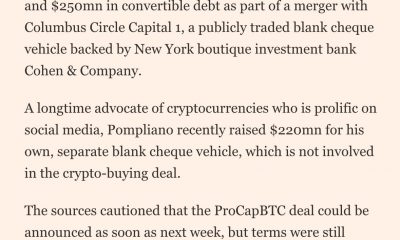

others
Index flat despite Tesla soaring 7.5% – Crypto News
- The S&P 500 closed up 1.23% last week to a new 2023 high of 4,450.
- The trading week is shortened due to the July 4 holiday in the US.
- Tesla released Q2 delivery data that soared above expectations.
- The US June jobs report, out Friday, is the major data release of the week.
UPDATE: The S&P 500 was flat a half hour into trading on Monday. The index started out the week in the red but has slowly moved back to even. The NASDAQ Composite has added 0.25%. Tesla stock has added 7.5% to trade above $281.
The S&P 500 index begins the week at a new high for the year based on the June 30 close at 4,450. The index has been on a steady upward trajectory since mid-March and shows no signs of stopping.
This quiet week will see a shortened trading schedule as the US Independence Day celebration on July 4 also means that the market will close at 1:00 PM EST on Monday, July 3, as well. With earnings out of the way, traders only have the June jobs report on Friday to look forward to. Monday should see trading begin on a positive note as on Sunday morning Tesla blew away the analyst class with strong delivery and production figures for the second quarter.
At the time of writing in Monday’s premarket, S&P 500 futures are flat, while NASDAQ 100 futures have advanced 0.1%.
S&P 500 News: Tesla delivers another surprisingly healthy quarter
On the back of federal tax subsidies and CEO Elon Musk’s strategy of major price cuts, Tesla delivered an impressive 466,140 electric vehicles globally in Q2. This was about 5% higher than analysts’ consensus forecast for 445,000 deliveries.
Based on the cross tabs, Tesla sold 446,915 lower-priced Model 3 and Model Ys and 19,225 higher-priced Model S and Model X vehicles.
Perhaps even more surprising, Tesla produced 479,700 vehicles in the quarter, which demonstrates how far management has ramped up capacity at its factories in Austin, Texas, Berlin and Shanghai. Tesla delivered 422,875 and produced 440,808 vehicles back in the first quarter of the year.
The delivery figure was 83% higher than a year ago and 10% higher than the first quarter. It now seems that Elon Musk’s remark back in January that deliveries could reach 2 million in 2023 – an idea that seemed implausible at the time – might be achievable. If deliveries continue to rise 10% QoQ in the back half of the year, then Tesla will deliver 1,965,798 total vehicles for the year. A slight uptick in the growth rate would be all that is needed to reach the 2 million target.
For now, the consensus still sees full-year deliveries at 1.8 million, but we may see analysts begin to revise their forecasts upward this week due to the Q2 data. Already, Canacorrd Genuity has raised its price target on TSLA stock from $257 to $293.
Tesla’s results could affect the entire market as it shows that consumer demand remains high at a time when many on Wall Street have been nervous about a looming recession. TSLA stock jumped 6.2% in Monday’s premarket to $278 on the news. With Tesla as a large component of its index, the S&P 500 will likely advance on Monday due to its outsized weighting and influence over other growth stocks.
Friday jobs report the pinnacle of a slow data week
The June nonfarm payrolls report is the largest focus on the economic indicator schedule this week. The consensus calls for a net 200,000 job hires in June, far below the figure from May. Back in May the consensus of 190,000 net hires was blown out of the water when the figure from the US Bureau of Labor Statistics reported 339,000 new jobs.
Could the analysts have it wrong once again? That would seem quite likely since much of the recent economic data in June outperformed the average. forecasts, The outlook for New Home Salesthe Q1 GDP growth rate and the Consumer Confidence Index all had to be revised upward when the data was reported last week.
The counter narrative comes from economists, who, broadly speaking, see a tightening credit market and a Federal Reserve sticking to higher interest rates as a recipe for slowing growth.
The day before on Thursday, July 6, ADP will give the market a hint. The company’s research arm will release its projection of the employment change in the US for June, which analysts have pegged at 180,000. The figure in May was 278,000.
The Institute for Supply Management (ISM) will also release two significant data points this week. Its June Manufacturing PMI for the US arrives on Monday after the market closes, and on Thursday it will release its US Services PMI for June. Both the indices are expected to improve from May’s numbers.
NonFarm Payrolls FAQs
Nonfarm Payrolls (NFP) are part of the US Bureau of Labor Statistics monthly jobs report. The Nonfarm Payrolls component specifically measures the change in the number of people employed in the US during the previous month, excluding the farming industry.
The Nonfarm Payrolls figure can influence the decisions of the Federal Reserve by providing a measure of how successfully the Fed is meeting its mandate of fostering full employment and 2% inflation.
A relatively high NFP figure means more people are in employment, earning more money and therefore probably spending more. A relatively low nonfarm payrolls’ result, on the other hand, could mean people are struggling to find work.
The Fed will typically raise interest rates to combat high inflation triggered by low unemployment, and lower them to stimulate a stagnant labor market.
Nonfarm Payrolls generally have a positive correlation with the US Dollar. This means when payrolls’ figures come out higher-than-expected the USD tends to rally and vice versa when they are lower.
NFPs influence the US Dollar by virtue of their impact on inflation, monetary policy expectations and interest rates. A higher NFP usually means the Federal Reserve will be more tight in its monetary policy, supporting the USD.
Nonfarm Payrolls are generally negatively-correlated with the price of Gold. This means a higher-than-expected payrolls’ figure will have a depressing effect on the Gold price and vice versa.
Higher NFP generally has a positive effect on the value of the USD, and like most major commodities Gold is priced in US Dollars. If the USD gains in value, therefore, it requires fewer Dollars to buy an ounce of Gold.
Also, higher interest rates (typically helped by higher NFPs) also lessen the attractiveness of Gold as an investment compared to staying in cash, where the money will at least earn interest.
Nonfarm Payrolls is only one component within a bigger jobs report and it can be overshadowed by the other components.
At times, when NFP come out higher-than-forecast, but the Average Weekly Earnings is lower than expected, the market has ignored the potentially inflationary effect of the headline result and interpreted the fall in earnings as deflationary.
The Participation Rate and the Average Weekly Hours components can also influence the market reaction, but only in rare events like the “Great Resignation” or the Global Financial Crisis.
Earnings of the week
Thursday, July 6 – Levi Strauss (LEVI)
What they said about the market – Michael Gapen
Bank of America economist Michael Gapen acknowledged in an investor note that the US economy has performed better than expected in the first half of the year. This solid performance, however, doesn’t mean the second half of the year will necessarily follow suit.
“We do not expect such robust prints to continue. Momentum in the economy should slow as the lagged effects of tighter monetary policy and financial conditions begin to take hold.”
S&P 500 forecast
The S&P 500 is back at a new annual high after it rebounded last week from the previous week’s sell-off. With a close at 4,450 on Friday, the expectation will be for it to easily reach 4,500 this week. The index last reached this point when it acted as stubborn resistance in April 2022. Prior to then, the region loosely guarding 4,600 also pushed prices back lower in February and March of last year.
The index is slightly overbought on the Relative Strength Index (RSI), but its sell-off two weeks ago did not last long. Only a severe drop in company earnings or a renewed bout of banking failures have the ability to push this index lower. If the mood does turn sour, then the 4,300 or 4,325 levels should provide it with short-term support. Medium and longer-term support are at 4,100 and 3,800, respectively.
s&p 500 daily chart
-

 Technology5 days ago
Technology5 days agoVisual effects veteran Ed Ulbrich joins AI company Moonvalley – Crypto News
-

 Technology5 days ago
Technology5 days agoVisual effects veteran Ed Ulbrich joins AI company Moonvalley – Crypto News
-

 Blockchain5 days ago
Blockchain5 days agoWhy Sandeep Nailwal Is Betting on Himself as Polygon CEO – Crypto News
-

 Cryptocurrency1 week ago
Cryptocurrency1 week agoAI Deepfakes Drove 40% of High-Value Crypto Fraud Last Year: Report – Crypto News
-

 De-fi5 days ago
De-fi5 days agoEthereum Staking Hits Record 35 Million ETH, Locking 28% of Supply – Crypto News
-

 Cryptocurrency5 days ago
Cryptocurrency5 days agoHyperliquid price outlook amid Eyenovia’s $50M HYPE treasury strategy – Crypto News
-

 Cryptocurrency5 days ago
Cryptocurrency5 days agoBitcoin Cash price forecast: BCH steady despite profit taking – Crypto News
-

 Blockchain5 days ago
Blockchain5 days agoCan BNB Punch Through The Ceiling Or Will 640 Catch The Fall? – Crypto News
-

 Blockchain5 days ago
Blockchain5 days agoCan BNB Punch Through The Ceiling Or Will 640 Catch The Fall? – Crypto News
-

 Cryptocurrency5 days ago
Cryptocurrency5 days agoBitcoin Pepe presale nears major milestone ahead of Fed decision – Crypto News
-

 Cryptocurrency1 week ago
Cryptocurrency1 week ago8,000 BTC Just Moved. BlackRock or Saylor? – Crypto News
-

 Blockchain1 week ago
Blockchain1 week agoShib Alpha Layer Marks End Of Meme Era – Crypto News
-

 Technology5 days ago
Technology5 days ago5 star window ACs built for efficient cooling, quiet performance, and long-term power savings: Top 8 picks – Crypto News
-

 Cryptocurrency5 days ago
Cryptocurrency5 days agoPEPE drops 20%, yet whales just bought 531B tokens – Here’s why – Crypto News
-

 Cryptocurrency5 days ago
Cryptocurrency5 days agoBinance, OKX Set Transparency Standard with PoR Reports as Coinbase Lags: CQ – Crypto News
-

 Metaverse1 week ago
Metaverse1 week agoBarbie maker Mattel partners with OpenAI to launch AI-powered toys in 2025 – Crypto News
-

 Cryptocurrency1 week ago
Cryptocurrency1 week agoDeFi’s top DAOs have huge treasuries – Yet they’re blind to THESE… – Crypto News
-

 others7 days ago
others7 days agoGBP/USD rebounds above 1.36 as Israel-Iran conflict deepens – Crypto News
-

 Blockchain6 days ago
Blockchain6 days agoJPMorgan Chase Says Deposit Token Is ‘Superior’ to Stablecoins – Crypto News
-

 Cryptocurrency5 days ago
Cryptocurrency5 days agoTruth Social files for a Bitcoin and Ethereum ETF – Crypto News
-
others5 days ago
United States 4-Week Bill Auction fell from previous 4.08% to 4.06% – Crypto News
-

 Cryptocurrency4 days ago
Cryptocurrency4 days ago$100,000 Bitcoin on Thin Ice as Major Death Cross Nears – Crypto News
-

 others1 week ago
others1 week agoThis Dogecoin Rival Could Go Higher Amid Increased Whale Activity, Says Analytics Platform Santiment – Crypto News
-

 others1 week ago
others1 week ago65-Year-Old Forced Out of Retirement After Losing ‘Everything’ in Elaborate Bank Fraud Scam – Crypto News
-

 De-fi1 week ago
De-fi1 week agoUniswap Launches Smart Wallets with One-Click Swaps, Bundled Transactions Powered by Alchemy – Crypto News
-

 Technology1 week ago
Technology1 week agoInfinix aims to be known as gaming-first brand, eyes tier 2, tier 3 cities: India CEO – Crypto News
-
![DIS Elliott Wave technical analysis [Video]](https://dripp.zone/news/wp-content/uploads/2025/06/DIS-Elliott-Wave-technical-analysis-Video-Crypto-News-400x240.jpg)
![DIS Elliott Wave technical analysis [Video]](https://dripp.zone/news/wp-content/uploads/2025/06/DIS-Elliott-Wave-technical-analysis-Video-Crypto-News-80x80.jpg) others5 days ago
others5 days agoDIS Elliott Wave technical analysis [Video] – Crypto News
-

 others5 days ago
others5 days agoTAC Raises $11.5M to Bring DeFi to Telegram’s Billion-User Ecosystem – Crypto News
-

 Technology5 days ago
Technology5 days agoGoogle Pixel 10 series may feature dual speakers and SIM tray shift, leak hints – Crypto News
-

 Technology5 days ago
Technology5 days agoTrump Adviser David Sacks Says China Adept at Evading Chip Curbs – Crypto News
-

 De-fi5 days ago
De-fi5 days agoTokenized Treasuries Surge to $5.6 Billion, Fueling Growth in RWAs: CoinGecko – Crypto News
-

 Technology1 week ago
Technology1 week agoGoogle Search is fading. The whole internet could go with it. – Crypto News
-

 De-fi1 week ago
De-fi1 week agoAnthony Pompliano to Lead ProCapBTC $750 Million Bitcoin Vehicle: FT – Crypto News
-

 Blockchain1 week ago
Blockchain1 week agoAmazon turns to nuclear energy to power AI facility – Crypto News
-

 others1 week ago
others1 week agoFormer Crypto Executive Appointed To Serve As SEC’s Director of Trading and Markets – Crypto News
-

 Technology1 week ago
Technology1 week agoBig tech on a quest for ideal AI device – Crypto News
-

 others1 week ago
others1 week agoAnalytics Platform Warns Bitcoin Is ‘Stalling’ Below Major Resistance Level, Says Breakout Won’t Happen Until This Happens – Crypto News
-

 Cryptocurrency1 week ago
Cryptocurrency1 week agoKlein Funding and Bybit Partner to Launch a New Era of Crypto Prop Trading – Crypto News
-

 Technology7 days ago
Technology7 days agoMark Zuckerberg teases Meta smart glasses with Oakley—What’s coming on June 20? – Crypto News
-

 Blockchain5 days ago
Blockchain5 days agoHow Low Can Cardano Go? Analyst Maps Final Crash Target – Crypto News
-

 De-fi5 days ago
De-fi5 days agoIran’s Largest Crypto Exchange Nobitex Hacked for Over $80 Million Amid Israeli-Iran Conflict – Crypto News
-

 others5 days ago
others5 days agoAlex Mashinsky Barred From Receiving Any Assets From Celsius Bankruptcy Claims – Crypto News
-

 Cryptocurrency4 days ago
Cryptocurrency4 days agoAERO price jumps 20% as it defies crypto downturn – Crypto News
-

 Metaverse1 week ago
Metaverse1 week agoBarbie maker Mattel partners with OpenAI to launch AI-powered toys in 2025 – Crypto News
-

 Technology1 week ago
Technology1 week agoGoogle, Apple clash with Meta over age checks on App Stores: All you need to know – Crypto News
-

 Cryptocurrency1 week ago
Cryptocurrency1 week agoBitcoin falls to $103K, options skew hits 3-month low as mideast tensions drive oil prices higher – Crypto News
-

 Blockchain1 week ago
Blockchain1 week ago7 Solana ETF Issuers File S-1, Analyst Doubts Next Week Approval – Crypto News
-

 Blockchain1 week ago
Blockchain1 week agoBillionaire Snaps Up $100M Of Trump Coin After Investigation Ends – Crypto News
-

 others1 week ago
others1 week agoPosts weekly loss, despite Friday rebound to 0.8100 – Crypto News
-

 Technology1 week ago
Technology1 week ago97% of Foxconn’s iPhone exports from India now headed to the US amid soaring China tariffs – Crypto News


















